Having a flat belly is just one of the benefits of core training. A strong mid-section helps you to maintain good posture throughout the day, as well as plays a role in preventing back pain and reducing the risk of injury in day-to-day life. In addition to the abdominal muscles, the core is also made up of deeper stabiliser muscles that surround the spine. The glute (buttock) muscles also help to control the core and protect the lower back, but these muscles can often become lazy, requiring the lower back to work harder. The following exercises help to build core stability, tone the abs and get the glutes firing to assist your middle muscles.
Guidelines
Perform one set of each exercise before moving on to the next move. Complete all five exercises in the circuit. Repeat the circuit three or four times, depending on your fitness level.
-
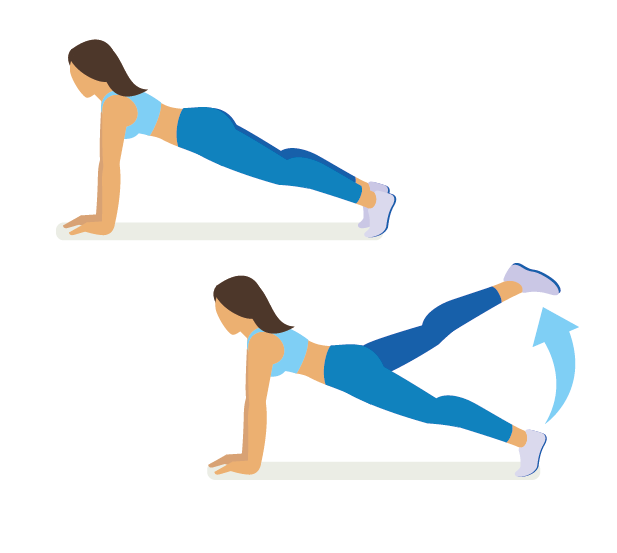 A/Plank leg lifts Begin in a plank position with your wrists directly under your shoulders and your body in a straight line from head to toe. Engage your core and squeeze your glutes. You may also squeeze your lats (just below your armpits) for added stability. Slowly raise one leg a few inches off the floor. Hold for a count of one then place it back on the floor. Repeat with the other leg to complete one rep. The aim is to keep your hips level as you lift and lower your leg. Exhale as you lift and inhale as you lower. Perform 10 reps in total.
A/Plank leg lifts Begin in a plank position with your wrists directly under your shoulders and your body in a straight line from head to toe. Engage your core and squeeze your glutes. You may also squeeze your lats (just below your armpits) for added stability. Slowly raise one leg a few inches off the floor. Hold for a count of one then place it back on the floor. Repeat with the other leg to complete one rep. The aim is to keep your hips level as you lift and lower your leg. Exhale as you lift and inhale as you lower. Perform 10 reps in total. -
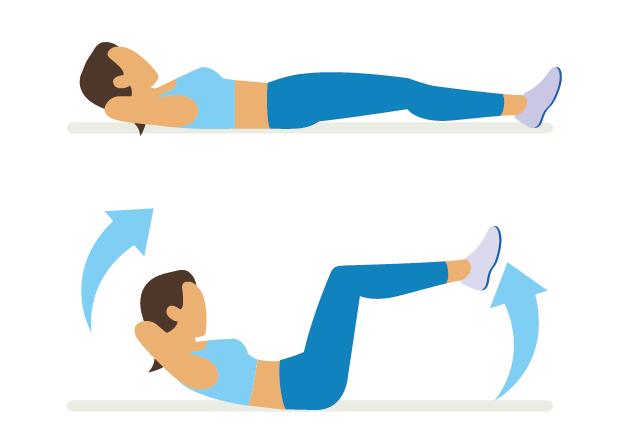 B/Double crunch Lying on your back with your legs straight, lightly rest your fingertips against the back of your head. Crunch upwards, bending your knees and lifting your feet off the floor. Aim to bring your chest and knees as close together as you can. Slowly reverse the movement, straightening your legs and keeping your feet an inch off the ground. Repeat the exercise, performing 10-15 reps in total, aiming to keep your lower back in contact with the floor throughout. Inhale as you crunch up then exhale as your lower back down. If you feel your lower back arching, extend your legs up at 45°. Placing both of your hands across your chest will also make the exercise slightly less challenging.
B/Double crunch Lying on your back with your legs straight, lightly rest your fingertips against the back of your head. Crunch upwards, bending your knees and lifting your feet off the floor. Aim to bring your chest and knees as close together as you can. Slowly reverse the movement, straightening your legs and keeping your feet an inch off the ground. Repeat the exercise, performing 10-15 reps in total, aiming to keep your lower back in contact with the floor throughout. Inhale as you crunch up then exhale as your lower back down. If you feel your lower back arching, extend your legs up at 45°. Placing both of your hands across your chest will also make the exercise slightly less challenging. -
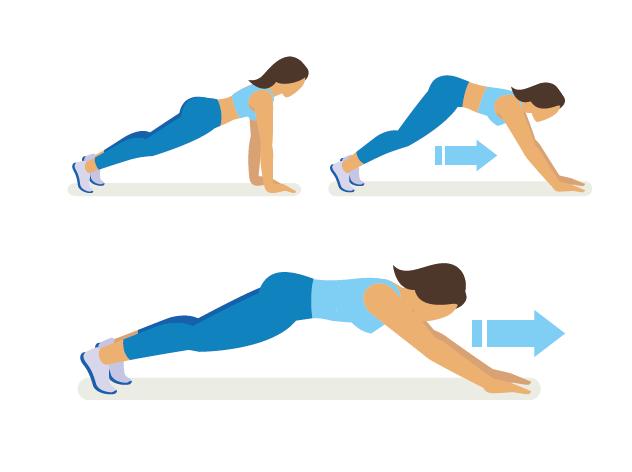 C/Plank walk out Begin in a plank position with your wrists under your shoulders, body in a straight line from head to toe, and glutes engaged. Lift one hand off the floor and walk it forwards a few inches, then do the same with the other hand. Do the same thing once more, then reverse the movement by walking your hands back to the start. This counts as one rep. Perform five reps in total, changing the leading hand with each rep. Aim to keep your hips completely level throughout, and your body in a straight line from head to toe. If you find your back arching at the end of the movement, reduce the number of steps you take with your hands.
C/Plank walk out Begin in a plank position with your wrists under your shoulders, body in a straight line from head to toe, and glutes engaged. Lift one hand off the floor and walk it forwards a few inches, then do the same with the other hand. Do the same thing once more, then reverse the movement by walking your hands back to the start. This counts as one rep. Perform five reps in total, changing the leading hand with each rep. Aim to keep your hips completely level throughout, and your body in a straight line from head to toe. If you find your back arching at the end of the movement, reduce the number of steps you take with your hands. -
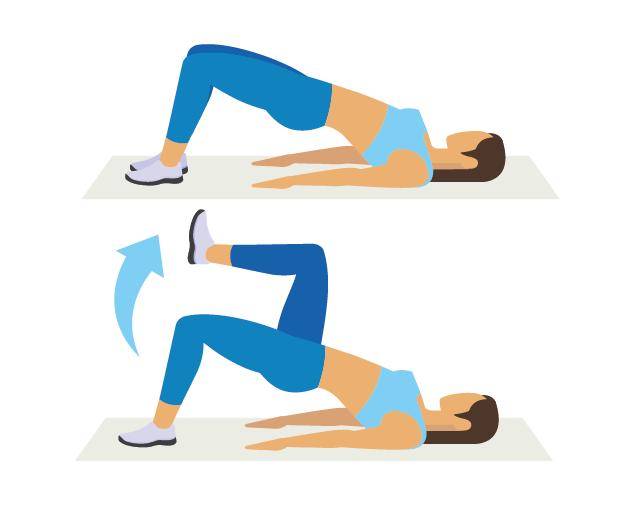 D/Hip bridge march Lying on your back with your arms by your sides and feet flat on the floor with your knees bent, contract your glutes and lift your hips off the floor into a bridge position. Try to create a straight line from your shoulders to your knees. Raise one foot off the floor and hold for a count of one, squeezing the glute of the opposite leg. Place the foot back on the floor and repeat on the other side to complete one rep. Perform 12-15 reps in total. Aim to keep your hips level throughout. If you find your hips moving as you lift and lower, try slowing the movement down and performing fewer reps.
D/Hip bridge march Lying on your back with your arms by your sides and feet flat on the floor with your knees bent, contract your glutes and lift your hips off the floor into a bridge position. Try to create a straight line from your shoulders to your knees. Raise one foot off the floor and hold for a count of one, squeezing the glute of the opposite leg. Place the foot back on the floor and repeat on the other side to complete one rep. Perform 12-15 reps in total. Aim to keep your hips level throughout. If you find your hips moving as you lift and lower, try slowing the movement down and performing fewer reps. -
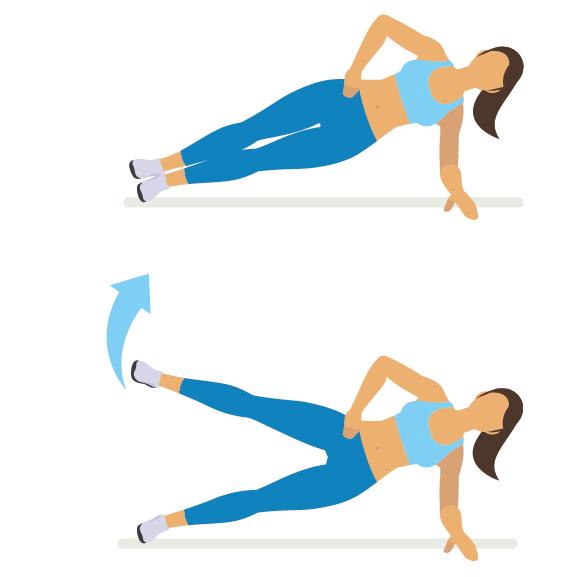 E/Side plank Begin lying on your side with your feet and hips stacked on top of each other. Your upper body is resting on your forearm, creating a straight line from your head to toes. Lift your top leg and hold for a count of one, then lower and repeat to complete 10 reps. Turn on to the other side and repeat, performing 10 more reps. Try to keep your hips and shoulders stacked on top of each other, as if you were balanced in a narrow space between two pieces of glass. If you find lifting and lowering your leg too challenging, or experience any discomfort in your knees, try holding a side plank for 20-30 seconds on each side instead.
E/Side plank Begin lying on your side with your feet and hips stacked on top of each other. Your upper body is resting on your forearm, creating a straight line from your head to toes. Lift your top leg and hold for a count of one, then lower and repeat to complete 10 reps. Turn on to the other side and repeat, performing 10 more reps. Try to keep your hips and shoulders stacked on top of each other, as if you were balanced in a narrow space between two pieces of glass. If you find lifting and lowering your leg too challenging, or experience any discomfort in your knees, try holding a side plank for 20-30 seconds on each side instead.






















